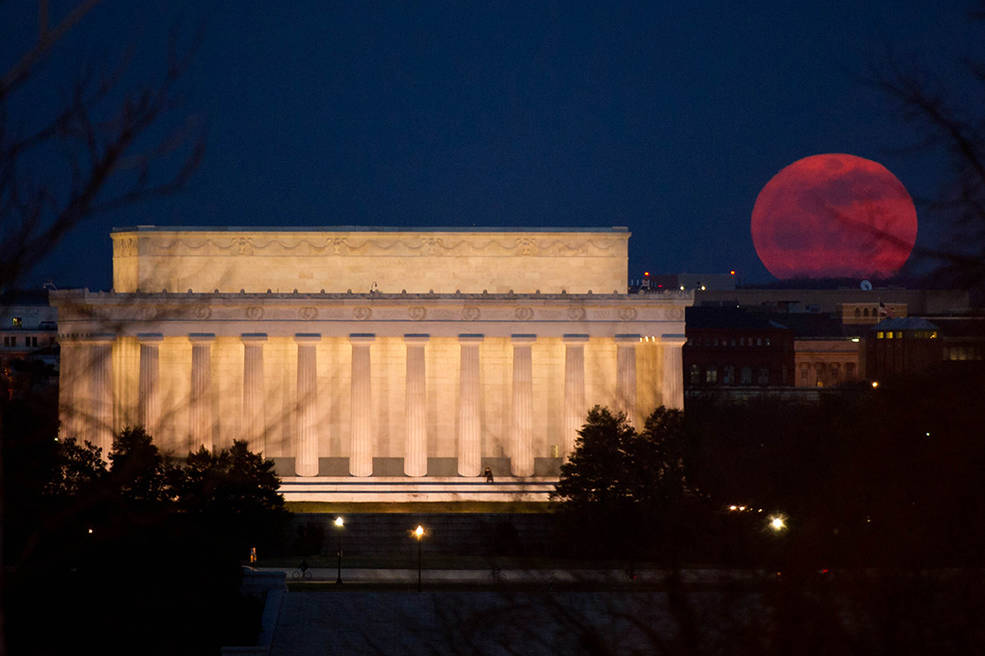November’s supermoon is something unique that will happen again in 2034, but you still have a chance to see it tonight. NASA said on its website that the moon is going to be visible on Sunday and Monday night. If you have missed it, today is your opportunity to be amazed and see a bigger and brighter moon.
The November supermoon is more than especial because it is the closest the moon will get to Earth at the same time it is lined up with the Sun, making the moon look even bigger and brighter than it usually looks when it happens to be just close to Earth. This event takes place thanks to the “syzygy” phenomenon, which is when the Sun, Moon, and Earth line up. The next syzygy will happen in 2034. The last one occurred in 1948.

The moon’s orbit around our planet is elliptical, thus, sometimes it is closer and sometimes it is farther away.
When the moon reaches the point closest to Earth —at perigee— it is 14 percent closer to our planet than when it is at apogee, which is the term for the point when the moon is farthest from the Earth. When at perigee, the moon shines 30 percent more and gives us a spectacular night sky.
Noah Petro, deputy project scientist for NASA’s Lunar Reconnaissance Orbiter (LRO) mission, assures that tonight the November supermoon will be visible.
“I’ve been telling people to go out at night on either Sunday or Monday night to see the supermoon.The difference in distance from one night to the next will be very subtle, so if it’s cloudy on Sunday, go out on Monday. Any time after sunset should be fine. Since the moon is full, it’ll rise at nearly the same time as sunset, so I’d suggest that you head outside after sunset, or once it’s dark and the moon is a bit higher in the sky. You don’t have to stay up all night to see it, unless you really want to!,” said Petro.
You can still see another supermoon on December 14. The activity is perfect for a romantic date. It is also a great opportunity to do something different with the kids and teach them a little about space. Tonight is a perfect night to take beautiful pictures and keep the moment forever.
A NASA photographer shares some tips to take great pictures of tonight’s supermoon
Bill Ingalls, a NASA’s senior photographer and a fixture at NASA Headquarters, has shared some tips on NASA’s website to help us take a great shot of tonight’s supermoon.
His most important tip is not to photograph the moon by itself. Instead, do it but including a local landmark, and if you do not live near one, add to the picture a house, your family or some natural background. Photographing the supermoon with another element in the frame will give your photo a sense of place.

Another important tip is to find a location to make the shot, and for this, Ingalls said we have to do a little research about where the moon is going to be and which places are great to see it and photograph it. He confessed that he uses Google Maps and other apps to chose his shooting place and he even does his homework a day in advance.
If you are asking yourself if your smartphone is capable of making a great shot of the supermoon, the answer is “yes.” Ingalls explained that it could be challenging, but you can do it. He warned that you might not get a giant moon in your picture, but you can do something panoramic and include an urban area in the background.
Once you have chosen your landscape with the moon in it, tap the screen of your smartphone and hold your finger on the supermoon to lock the focus. Then, slide your finger up or down to darken or lighten the exposure, and after you are satisfied with what you see, take the shot and keep the picture as the memory of the 2016 unique supermoon.
For digital SLR photography, Ingalls recommended using the daylight white balance setting because the moon reflects sunlight. And for those people using big lenses, he said it is important to keep in mind that the moon is a moving object and the shutter speed will probably need to be a lot faster when you finally decide you have the right exposure.
Source: NASA
